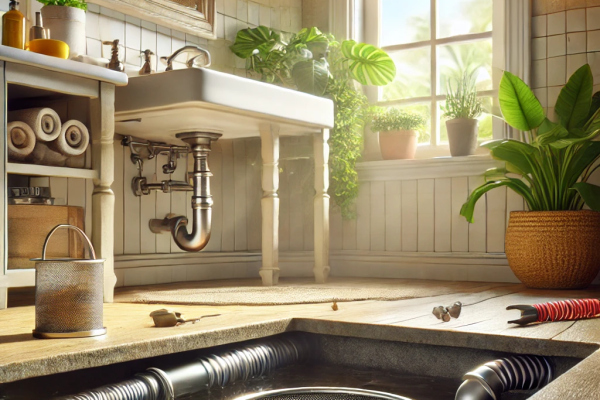
Slow Drains at Home in Texas? Here’s How to Solve the Problem Once and for All!
A slow drain can be a major inconvenience for homeowners, especially when water struggles to flow down the sink. But if you live in Texas, don’t worry—there are solutions. In this article, we will explore the common causes of slow drains, the impact of Texas’ unique climate on plumbing, and the best ways to resolve the issue quickly.
Chapter 1. Why Slow Drains Are More Serious Than They Seem
At first, a slow drain may seem like a minor problem, but it can be a sign of more significant issues. A gradual buildup of clogs can eventually lead to complete blockages, potentially damaging your entire plumbing system. Constant moisture in pipes can also create unpleasant odors, making your home less comfortable.
Given Texas’ heat, drought conditions, and frequent rain, soil shifts and tree root growth can exacerbate plumbing problems. Acting quickly when you notice slow drains can help prevent long-term damage.
Chapter 2. Five Common Causes of Slow Drains
Understanding the root cause of your slow drain is key to solving the problem effectively. Here are five common causes of slow drains in Texas homes:
2.1. Hair, Soap Scum, and Small Debris
Hair, soap scum, hygiene products, and other debris can accumulate in pipes, narrowing the drain and slowing water flow. This issue is often worse if there are people with long hair or pets in the house.
What you can do:
- Install mesh strainers in sinks and showers to catch debris.
- Clean these strainers regularly.
- Occasionally use mechanical or mild chemical solutions to prevent severe clogs.
2.2. Grease Buildup
In Texas, cooking, especially frying and barbecuing, can lead to significant grease buildup in pipes. When hot grease cools, it solidifies and sticks to the pipe walls, causing clogs.
How to prevent it:
- Never pour hot grease down the drain; dispose of it in the trash.
- Wipe excess grease off pans before washing them in the sink.
- Occasionally flush drains with boiling water to clear small grease deposits.
2.3. Tree Roots
Texas is home to lush vegetation, and tree roots can infiltrate plumbing systems, particularly during periods of rainfall. Over time, roots grow inside pipes, creating blockages.
What to do:
- Regularly inspect sewer lines to detect root intrusion.
- Plant trees a safe distance from plumbing systems.
- Consult a plumber if frequent clogs occur; they can perform a video inspection to check for root damage.
2.4. Worn or Old Pipes
Older homes with aging pipes may experience slow drains due to corrosion, rust, and mineral buildup that narrows the pipe’s interior. If your house is older or located in a historic Texas neighborhood, it may be time for a plumbing upgrade.
The solution:
- Hire a professional to inspect your pipes.
- Replace old pipes with modern materials resistant to corrosion.
- Monitor water pressure and watch for signs of rust or leaks.
2.5. Foreign Objects
Small items, like caps, toys, or jewelry, can accidentally fall into drains, causing blockages. In toilets, people sometimes flush things that shouldn’t be flushed.
How to handle it:
- Keep small items away from drains.
- If something falls in, retrieve it using a hook or vacuum tool.
- If an object is lodged deep in the pipe, contact a plumber to remove it.
Chapter 3. Methods to Solve and Prevent Slow Drains
If you’ve noticed water pooling in your sink or shower, there are several methods you can try to resolve the issue. If these don’t work, contacting a professional plumber is the best option.
3.1. Mechanical Methods
- Plunger: A common household tool, the plunger can help create pressure changes to push or pull clogs through pipes.
- Plumber’s Snake (Auger): This flexible cable is ideal for tough clogs, breaking up or removing blockages.
3.2. Chemical Products
Various store-bought chemical solutions can dissolve organic debris and grease.
Important precautions:
- Always follow safety guidelines—wear gloves and goggles, and avoid inhaling fumes.
- Never mix different chemical products, as they may react dangerously.
3.3. Natural Solutions
- Baking Soda and Vinegar: Pour half a box of baking soda into the drain, followed by vinegar. Wait a few minutes, then rinse with hot water.
- Boiling Water: A few liters of boiling water can break down soap scum and grease buildup.
3.4. Professional Assistance
If DIY methods don’t solve the problem, calling a plumber is the safest and most effective solution. Texas plumbers are experienced with local plumbing issues and can provide in-depth inspections, clearing blockages and identifying potential weak spots.
Chapter 4. Texas Living: How Climate and Conditions Affect Your Pipes
Texas’ diverse climate can have a significant impact on plumbing systems. Whether you’re dealing with drought, heavy rainfall, or hard water, these environmental factors can affect the condition of your pipes.
- Drought and Shifting Soil: Dry conditions cause soil to contract, which may shift pipes and create micro-cracks.
- Heavy Rains: Intense rain can encourage plant growth, with tree roots often seeking out moisture and invading plumbing systems.
- Mineral Deposits: Hard water in certain parts of Texas leads to scale buildup, which can narrow pipes over time.
Chapter 5. Ongoing Preventive Measures for Peace of Mind
To keep drains running smoothly, it’s essential to adopt a few simple habits:
- Run hot water through sinks once a week to prevent grease buildup.
- Use mesh strainers in all drains and clean them regularly.
- Avoid flushing large food scraps, especially bones, eggshells, and fibrous vegetable peels.
- Fix leaks quickly to avoid excess moisture and corrosion.
- Schedule professional pipe inspections every few years, especially if your home is in a high-risk area.
Chapter 6. When Is It Time to Call a Plumber?
While many homeowners try DIY fixes, there are times when it’s best to call a professional plumber:
- The slow drain persists after multiple attempts at mechanical or chemical cleaning.
- A foul odor is present, indicating organic material buildup.
- Water backs up when using appliances like dishwashers or washing machines.
- Your home has older pipes (e.g., cast-iron or clay), and issues are recurring.
- You live in an area with invasive tree roots that continually affect your plumbing.
A professional plumber can quickly diagnose and fix the issue, saving you time, effort, and money.
Conclusion
Slow drains can be a frustrating problem for homeowners, but understanding the causes and taking the right steps can restore your plumbing’s functionality. In Texas, where the climate and soil conditions can further complicate plumbing systems, staying on top of maintenance is key to avoiding major issues. By addressing slow drains promptly and implementing preventive measures, you can ensure your home remains comfortable and your plumbing stays in top condition.
If DIY methods don’t work or if you suspect the pipes are aging, don’t hesitate to call a professional plumber. Proper maintenance and timely repairs are essential to keep your plumbing system in great shape, no matter where you live in Texas.






